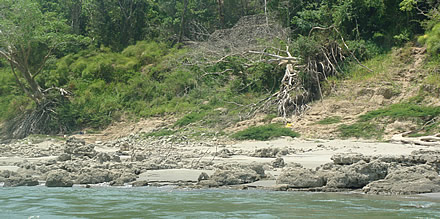

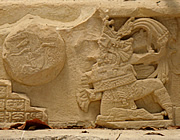
Yaxchilan is a fabulous large Mayan site with many impressive ruins to explore, famous for intricately carved lintels in doorways and a wonderfully evocative depiction of the ball game.
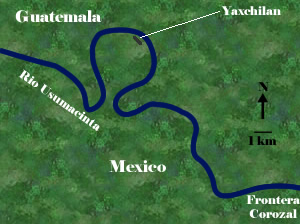
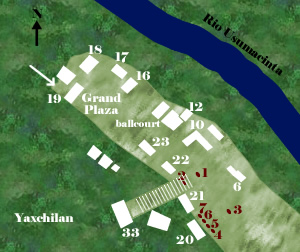
Mesoamerican civilisation is divided into pre-Classic, upto about AD 300, Classic, up to AD 800-900 and post-Classic from then to the Spanish conquest in the sixteenth century.
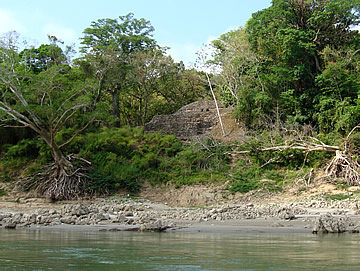
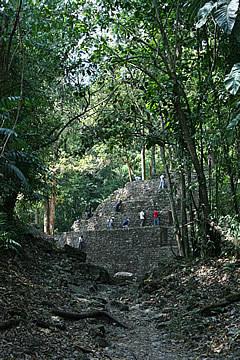
Yaxchilan had its origins in pre-classic times but it was as a Classic-era city that it saw its greatest development between AD 400 and AD 800, becoming the regional capital when K'inich Tatb'u Skull II came to the throne in 526. Under the rule of Shield Jaguar IV in the late seventh century A.D. it reached its peak of influence over the surrounding cities. As with many other Mayan cities it declined in the ninth century.
Identification of the Rulers of Yaxchilan follows Martin & Grube, 1 but it is a little confusing, especially when it comes to the numbering - whether Shield Jaguar III or IV for instance. Principal amongst these are Shield Jaguar III (681-742) and his son Bird Jaguar IV (752-768).
Set in a horseshoe loop of the Rio Usumacinta surrounded by dense jungle Yaxchilan echoes with the noise of howler monkeys and insects - a very atmospheric place.
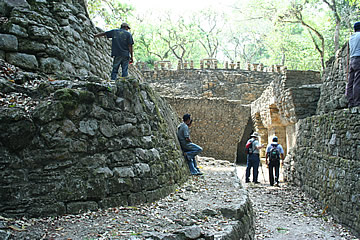
It is renowned for its ornately decorated temples strung out on a terrace on low hills high above the main plaza and especially its richly carved lintels which are a particular feature of the city. Most of the carvings we saw date from the reign of Shield Jaguar III and his son Bird Jaguar IV.
We approached from the river north-east of the city, which is aligned on a north-west south-east axis. The site is actively undergoing renovation and we could see a number of men with hand tools working on the face of a pyramid.
The Great Plaza is entered via Structure 19 through a dark passageway up narrow stairways known as the Labyrinth, inhabited by numerous bats.
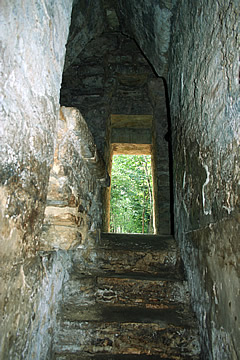
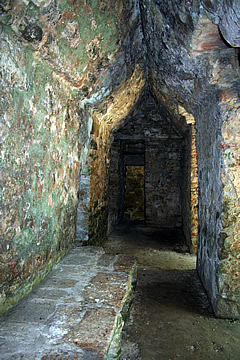
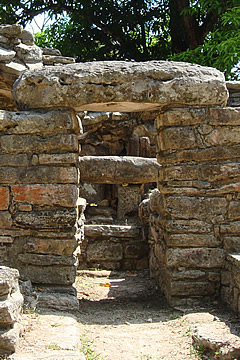
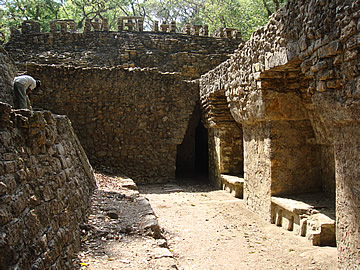
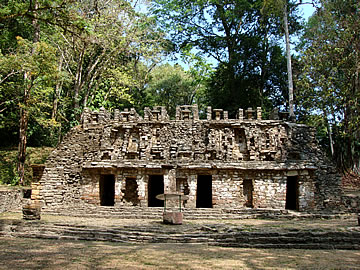
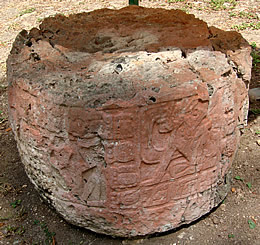
Emerging into daylight you are in the Grand Plaza of the Central Acropolis, a vast space. If this were an original entrance to the Grand Plaza it was obviously designed to impress the visitor with a sudden view of monumental buildings, but it does seem a strange approach. Now, though much cleared, the Grand Plaza is still quite overgrown with trees so that it looks as if the site could disappear into the jungle again in a very short time.
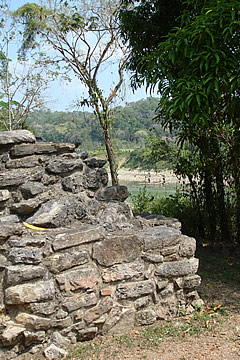
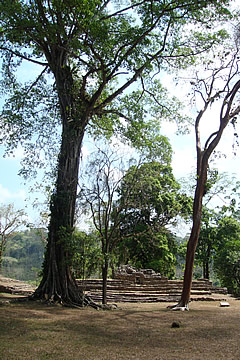
At this northern section of the site is a long stepped platform aligned north-east south-west with Structure 19 at its western edge and Structure 18 at the east. Its eastern edge lies very close to the perimeter of the site from where there is a steep drop to the river. A roadway leads south-east from this platform, in front of Structure 18, through the Grand Plaza.
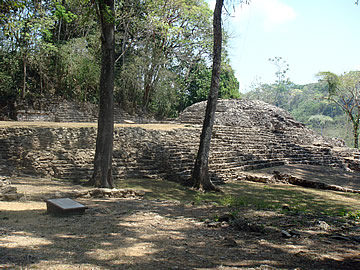
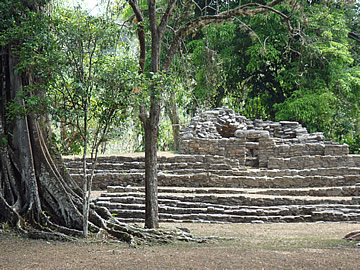
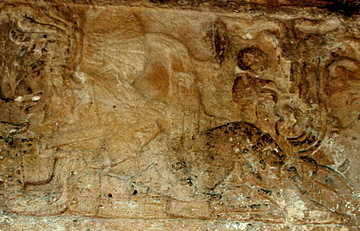
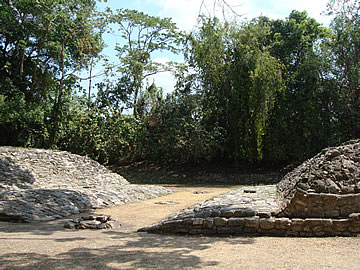
Structure 17 lies south-east of the platform and is one of the more unusual buildings, thought to have been a ritual cleansing sauna.
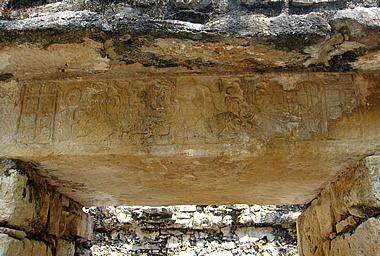
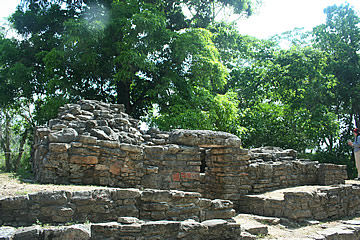
Yaxchilan is most famous for its intricately carved lintels. These huge rectangular stones rest on the tops of walls to from doorways into buildings and were most often carved on the underside. These are not easy to look at and so there must have been some other specific purpose in placing the carving on the underside. Perhaps passing beneath the carving conveyed some form of power or authority.
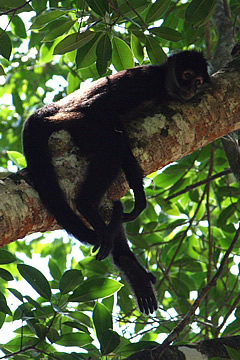
Three lintels which were unusually carved on their vertical faces can be found in Structure 16 which lies south-east of 17. These are designated 38, 39 and 402 and all three are carved only on the front edge.
Lintel 39 probably shows one of the important rulers, reclining and holding a massive serpent bar - several of the stelae at Quirigua have rulers holding serpent bars. These are horizontal bars with a serpent at each end, sometimes breathing fire, others have a demon or god emerging from the serpent's jaws. Serpents were revered by the Maya; as in many cultures their ability to shed skin and emerge renewed represented rebirth.
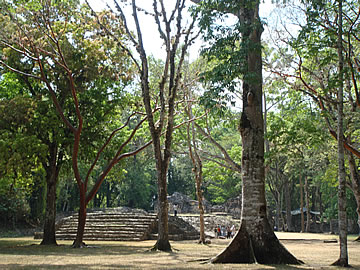
All the time we were looking around Yaxchilan we were accompanied by the noises of the jungle: insects, birds and monkeys lazily making their way through the trees.
There are two ballcourts at Yaxchilan, the larger is on the north-eastern edge of the Grand Plaza.
Five ballcourt markers were found in situ: three aligned along the centre of the playing area and one on each of the platforms.
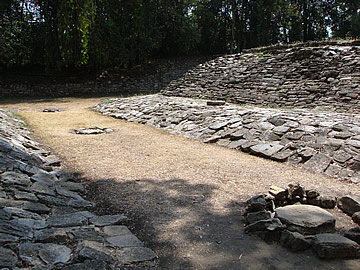
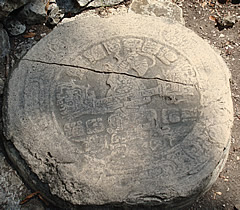
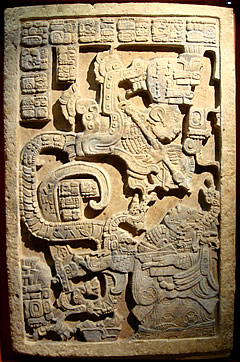
The best preserved of the markers again shows a ruler holding a ceremonial serpent bar.
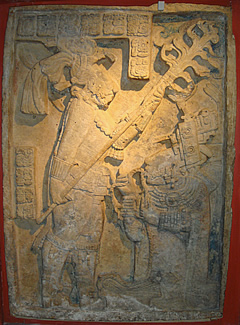
Opposite the ballcourt, on a ridge facing the river, is Structure 23. Two wonderful lintels from this building were removed on the orders of Arthur Maudslay who investigated several Mayan sites in the latter half of the nineteenth century.
As well as making plaster casts of many lintels at Yaxchilan he removed a total of eight. He left his collection to the British Museum where it is possible to see some wonderfully well-preserved carving in these original lintels as well as a number of casts.
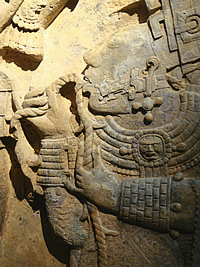
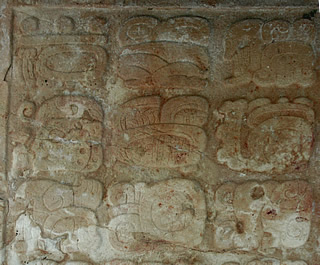
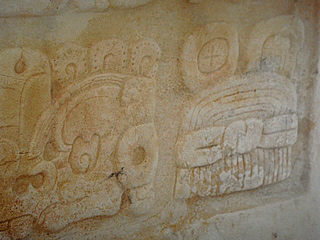
Two of the lintels from Structure 23 were on display when we visited in 2013; these were Lintels 24 and 25, commissioned by Shield Jaguar III to record the rituals commemorating his accession to the throne in AD 681. They show Shield Jaguar III and his wife Lady Xoc performing a blood-letting ritual.
The deeply incised carving of these wonderful lintels demonstrates how all of the sculptures would have looked originally.
Next to the ballcourt is Structure 12, a small eighth century building, with two lintels in situ, both carved on the underside. One, Lintel 37, is very well-preserved and shows a grid of hieroglyphs. The second is also a grid of glyphs but is much more worn.
It is thought that Bird Jaguar IV had Structure 12 built to house these lintels which record the history of the first nine rulers of Yaxchilan; the lintels are centuries older than the building.
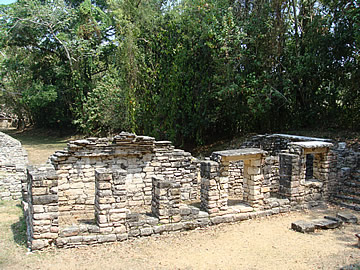
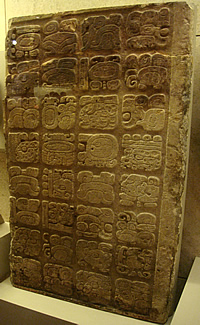
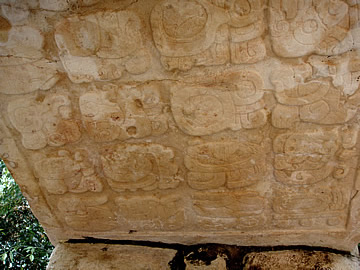
Bird Jaguar IV is known for a programme of building and improvments to the city, always careful to retain important older artefacts in the Mayan tradition.
Megan E O'Neill in her article Object, Memory and Materiality at Yaxchilan: the reset lintels of Structures 12 and 22,3 provides a wonderful overview of the work that has been done on researching Structures 12 and 22. The lintels of Structure 12 are identified as sixth century placed into the eighth century building. The building originally had seven doorways on the front, each with a carved lintel, and one on each end, only one of which had a carved linel. Only one of the lintels was pictorial and this was above the central front face doorway3, though this central aperture had a lintel carved with hieroglyphs when we saw it. The others formed two sets. One set of three has a full figure Long Count of 9.4.11.8.16 translating as 1 February AD 526 and a narration of the accession of Ruler 10 K'inich Tatbu Skull II. Lintel 37 belongs to the second set of four lintels which recounts the history of Yaxchilan through its first ten rulers.
Lintel 35 was originally set in Structure 12 in the doorway to the left of Lintel 37 and to the right of the central doorway and is the culmination of the historical sequence ending with the accession date of Ruler 10. It now resides in the British Museum.
Near to Structure 12 three buildings form an L-shape, one of which is Structure 10, where we saw more lintels carved with hieroglyphs. These describe the birth and accession of Bird Jaguar IV.4
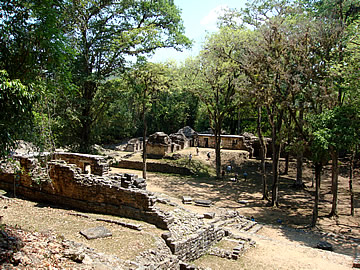
We had now reached a clearing where there was once the main entrance into the city from the river, flanked by Structures 6 and 7. Both these buildings had three doorways facing the river and three facing the plaza.4
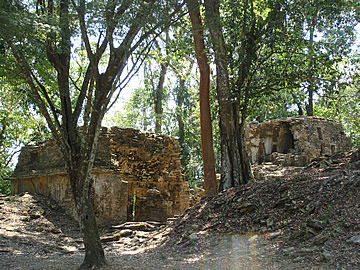
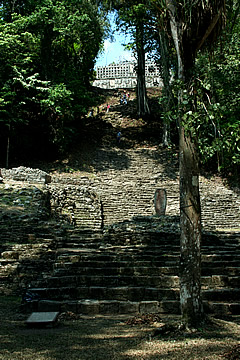
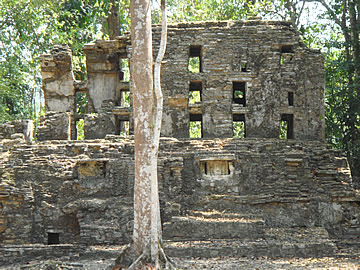
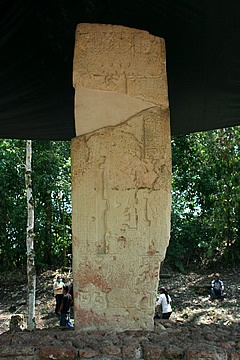
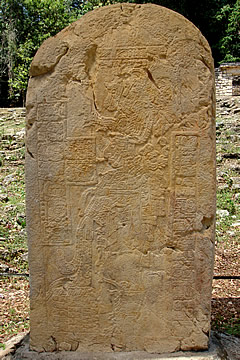
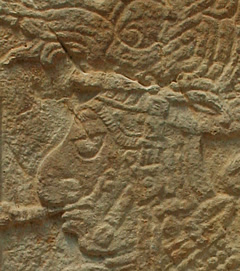
Structure 7 is in a poor state of repair but Structure 6 is much better and retains a deep, double-walled roof-comb. Its three doorways into the plaza were closed off some time in the past and new doorways created in the side walls. In one of the plaza-facing niches is a huge panel carved into a mask, possibly of the Rain God Chaac.
Across the clearing a monumental staircase ascends south west to Structure 33.
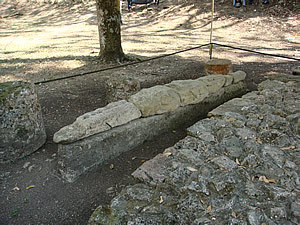
Here at the foot of the monumental staircase and nearby were the first stelae we saw at Yaxchilan. Carolyn Tate, in an article entitled ""The Period-Ending Stelae of Yaxchilan"5, describes how there were once over thirty stelae at Yaxchilan and discusses in detail eleven which were grouped in and near the main plaza. All of these eleven were carved with king figures dressed as warriors on the broad side facing the river, and ritual scenes on the temple-facing side. Being visible from the river they were designed to impress upon travellers the magnificence and power of the ruler. When stelae fell, as the city decayed, the lower surfaces were quite well preserved while the exposed surfaces became badly worn due to weather erosion.
Stela 1 stands in the main plaza between the monumental staircase and the river. It is unusual in being placed on a substantial platform and flanked by sculptures of crocodiles - though these are very weathered.
Nearby are five more stelae: 3,4,5,6 and 7. The hieroglyphs on the temple sides celebrate accession anniversaries and Period Endings.5
When Yaxchilan was intact it must have displayed a comprehensive history of the city as seen through the eyes of the rulers, marking great events, particularly on the field of battle and in the lives of the elite, and designed to impress both citizens and vistors.
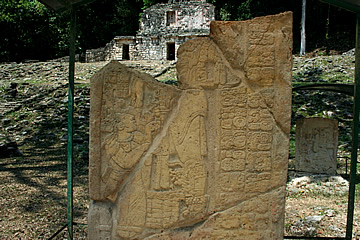
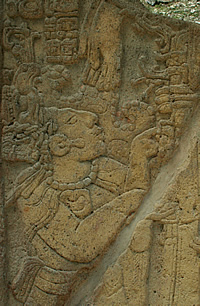
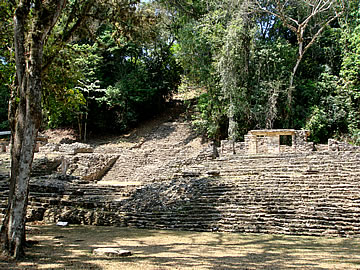
Though the portraits of rulers and captives may be stylised, looking at them seems to bring the actual people very much closer. Real people and real events are depicted here - the closest we'll get to visuallising this society.
Structures 20 and 21 stand on the left hand side of the monumental staircase at the lower end.
Structure 20 has two beautifully carved lintels: 13 and 14, of which 14 is in superb condition.
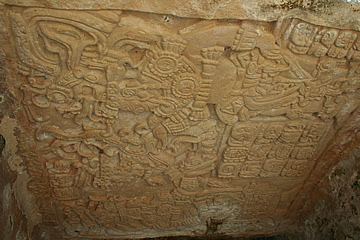
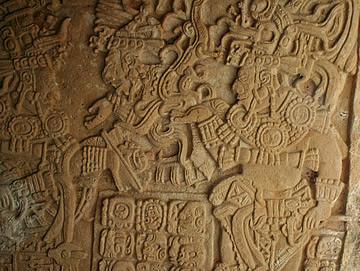
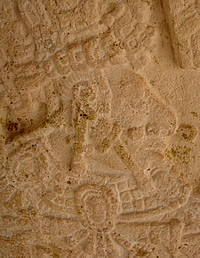
On Lintel 13 Bird Jaguar IV and his wife Lady Chak Chami hold blood-letting instruments. They must have just completed a blood ritual to conjure up a vision of a serpent; an image of their child Shield Jaguar IV, emerges from between the jaws of the serpent.2
On Lintel 14 Chak Chami is portrayed with her brother, again with blood-letting instruments, and a conjured serpent and child Shield Jaguar IV.2 Her brother is identified as the guardian of the king hence, I suppose, his appearance in such an important position, mirroring that of the king himself in Lintel 13.
This is a really impressive lintel and, seen in situ, gives a good impression of how beautiful and awe-inspiring Yaxchilan must have been.
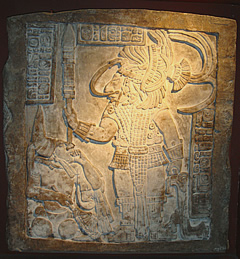
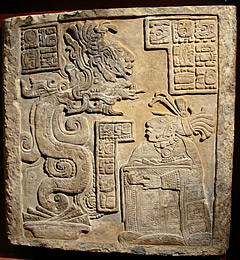
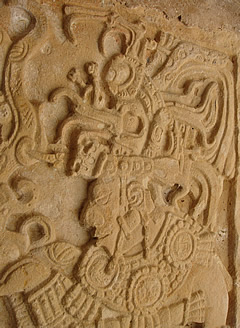
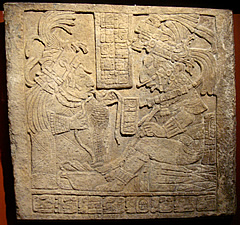
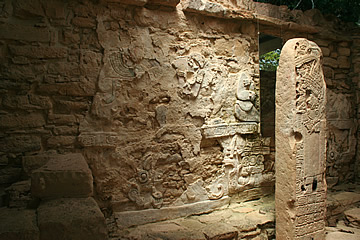
Structure 21 retains beautiful decoration and sculpture, this time in the form of a stela and stuccoed walls. Three lintels from this building were also removed on the orders of Arthur Maudslay and are now displayed in the British Museum: Lintels 15,16 and 17 show Bird Jaguar IV enacting a blood-letting ceremony.
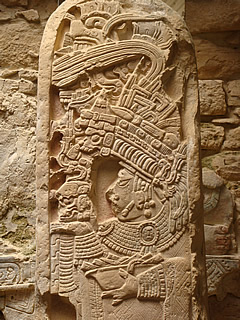
The ceremony is the same as that enacted by his father Shield Jaguar III almost 50 years earlier shown in lintels from Structure 23. Bird Jaguar IV was officially pronounced king on 3rd May AD 752 after the capture of high-ranking prisoners and the birth of a male heir. The captions for these lintels and others in the British Museum use information both from the British Museum and the online Peabody Museum Corpus of Maya Hieroglyphic Inscriptions.
Blood was an essential of many rituals. Sacrificing the life force of the most important members of the society as well as the lives of the most prestigious prisoners was believed to ensure the favour of the gods.
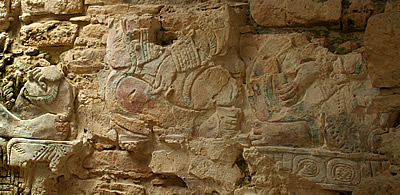
Within Structure 21 Stela 35 depicts Lady Ik Skull, the mother of Bird Jaguar IV, a princess from Calakmul. She is also known, rather beautifully, as Lady Eveningstar. Behind her the wall was once covered with life-size stucco figures, coloured fragments of which remain.
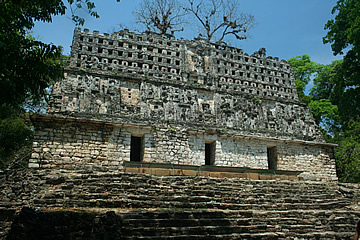
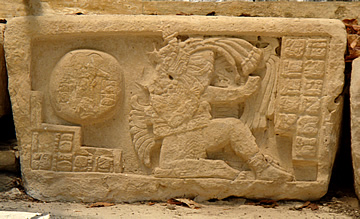
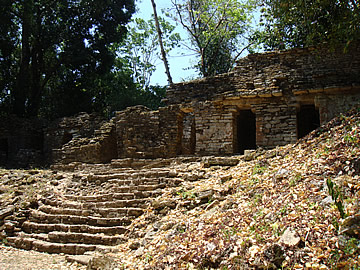
We continued climbing the monumental staircase, passing Structures 25 and 26 on the way - ruined but rather atmospheric among the trees.
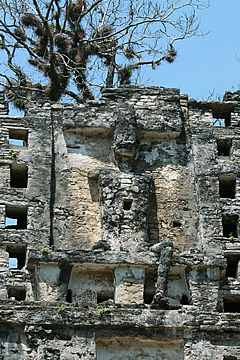
Though Structure 33 can be seen from the plaza below, as you climb the steps it is only gradually fully revealed.
Built by Bird Jaguar IV at the highest point of the Central Acropolis, Structure 33 was intended to impress and demonstrate his power.
His father, Shield Jaguar III, had married Lady Ik Skull from Calakmul in an effort to bring peace to the warring cities. As the son of a foreign princess, however, Bird Jaguar IV was not totallly trusted by the people of Yaxchilan. When he became ruler he emphasised his power and lineage in a number of ways. Creating new buildings which incorporated older lintels depicting ancestral rulers as in Structure 12, lintels in Structure 21 which show him performing the same blood-letting ceremony as his father in older lintels in Structure 23, and here, in Structure 33, a beautiful carved frieze at the base of the building showing Bird Jaguar IV playing the ball game with a huge ball enclosing a captive and watched by two dwarfs. On the left his father is shown and on the right his grandfather, both also playing the ball game.
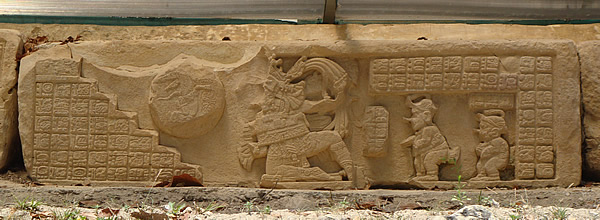
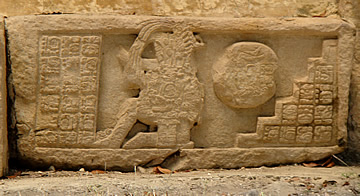
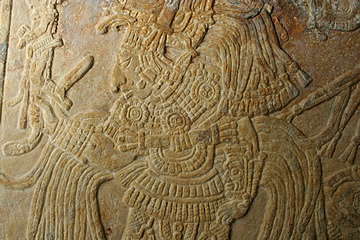
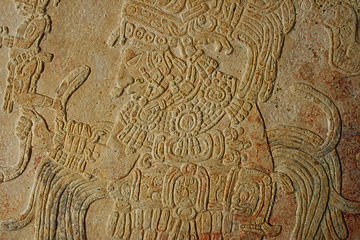
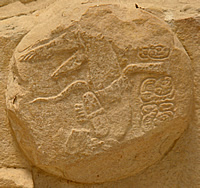
This is a largely intact structure, with wonderful carvings, standing high about the city. Yaxchilan wouldn't have had the resources, nor the manpower, to create magnificent pyramids such as can be seen elsewhere in the Mayan world, but by exploiting the local topography they too could create awe-inspiring buildings.
Within the structure three lintels: 1,2 and 3,are very well-preserved with deeply carved images of Jaguar IV in various dance ceremonies.2
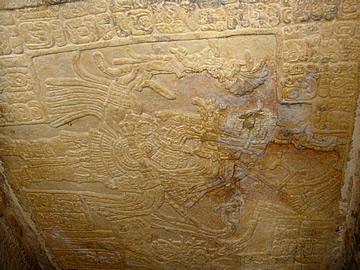
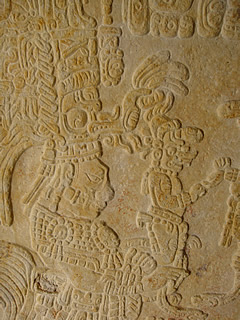
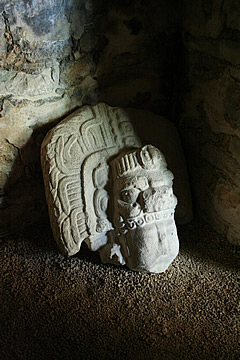
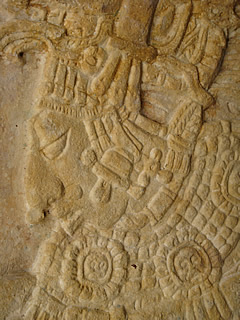
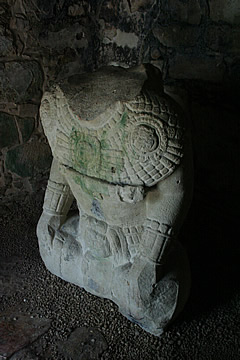
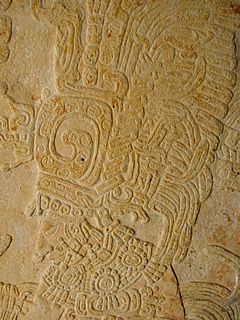
Also inside the building is a headless statue, probably once depicting Bird Jaguar IV, and the sculpted head. The niche in which it stands would be illuminated by the sun at sunrise on the summer solstice.
We went around the back of Structure 33 to begin our return journey to the boat.
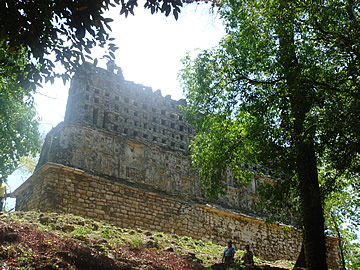
We passed more quite substantial ruins, part of the West Acropolis, like the South Acropolis which we did not visit, very much smaller than the Central Acropolis.
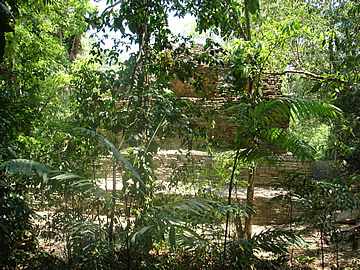
All of this area was quite thick jungle - it must take a good deal of work just to stop the vegetation from taking over. Very atmospheric though!
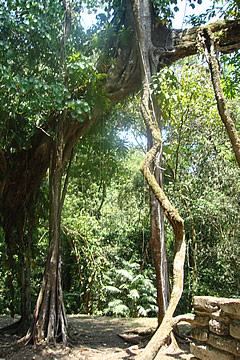
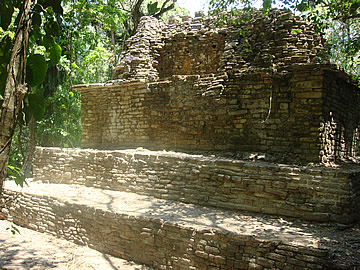
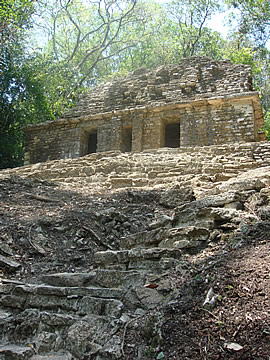
We returned on the river to have lunch - a very cooling 40 minute boat ride - before travelling to Bonampak.
